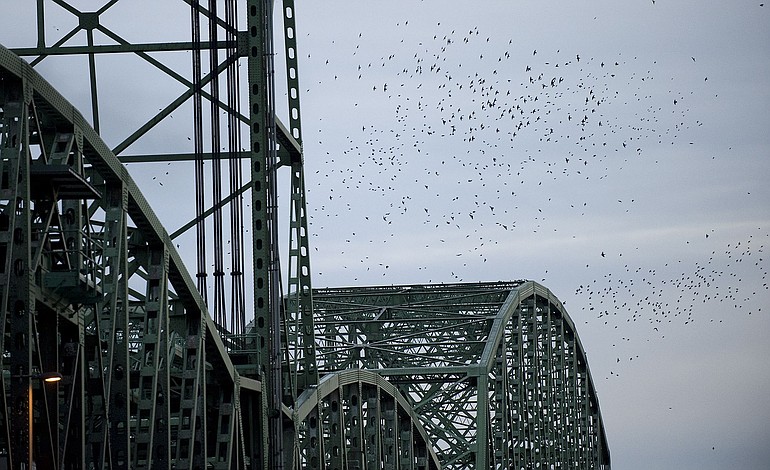A volley of cannon fire greeted afternoon commuters on the Interstate 5 Bridge on Monday, the first day of a semi-annual campaign to scatter a pooping horde of non-native birds.
At 3:30 p.m., cued by an automated timer, four propane orchard cannons began popping off in random fashion. Flocks of pigeons swirled around with each report, a twilight serenade that will continue through early March.
The Oregon Department of Transportation, which maintains the bridge, has used the air cannons off and on since 2003 to scatter as many as 30,000 starlings that perch on the steel lattice work. The birds typically congregate together during winter nights. Since bridge workers first noticed them in the early 1980s, the starlings have steadily turned the twin freeway spans into the Studio 54 of the avian world.
“It’s a big bird cage,” said Marc Gross, ODOT bridge supervisor. “It’s got a lot of edges, and they love edges.”
So many starlings in such a condensed space equates to a massive abundance of slippery bird poop. Gross said the fecal matter not only creates a slip and trip hazard, it presents a disease risk to pedestrians, bicyclists and bridge workers.
In addition, the acidic bird poop degrades the iron cables that lift the bridge deck for boats.
“It eats it away,” Gross said. “Those cables, that’s the lifeblood of the span and they’re very expensive to replace.”
Workers mounted three of the cannons around the traffic deck, and two atop the draw spans 239 feet above the river surface. Budget constraints forced ODOT to skip the cannon treatment last winter, but the agency came up with the $7,000 to $8,000 necessary to resume this year.
In addition, the U.S. Department of Agriculture will periodically send workers along the bridge banging on the equivalent of pots and pans. In such a congested urban environment, shooting the birds is out of the question.
“We want to try to disrupt their routines so they don’t get used to the sounds,” Gross said.
Starlings, native to Europe, have created problems ever since being introduced as pets in the late 1800s.
A local birding expert said members of a Seattle-area Audubon chapter years ago went so far to rig up a series of traps. Wilson Cady, a longtime activist with Vancouver Audubon, said the group tried to perfect a recipe that they hoped might take hold with the public.
“The idea was to get them in the food chain,” Cady said. “I understood they weren’t too bad.”
Like many non-native species of plants or animals, starling populations spiraled in the absence of natural predators and diseases of their home range in Europe. Cady noted that, even as starling populations are now dropping in Europe with the loss of habitat, they remain a vexation for many bird enthusiasts in the Pacific Northwest.
The bird is notorious for taking over the nesting cavities of native birds such as purple martins and western bluebirds, while raiding commercial cherry and blueberry crops.
Cady’s no fan of starlings, but he admits a grudging appreciation.
“They’re a smart bird, they’re a survivor,” he said. “And they’re going to be here whether we want them or not.”



